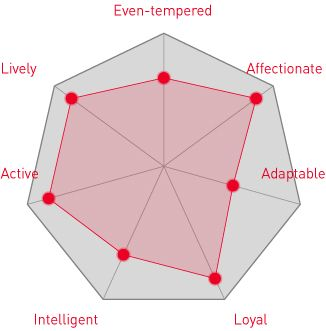
Let's talk Boxers
Known for their playful and friendly nature, Boxers are full of bouncy exuberance. A little boisterous at times, they have an abundance of energy and a great zest for life. With early training, Boxersalso make loyal and devoted companions, and develop a deep attachment to their human families. Really deep. In fact, they like nothing better than being right by your side –and will even fall asleep on your knee, if you let them.
Official name: Boxer
Other names: German Boxer, Deutscher Boxer, American Boxer
Origins: Germany

| Drooling tendencies |
|
Warm weather | |
| Grooming needs | |
Cold weather | |
| Shedding level | |
Suited to apartment living |  |
| Barking tendencies | Medium | Can stay alone | |
| Energy Level (high, low, medium) * | Medium to high | Family pet * | |
| Compatibility with other pets | |
* We advise against leaving pets alone for long stretches. Companionship can prevent emotional distress and destructive behaviour. Speak to your veterinarian for recommendations.
Every pet is different, even within a breed; this snapshot of this breed specifics should be taken as an indication.
For a happy healthy and well-behaved pet, we recommend educating and socializing your pet as well as covering their basic welfare needs (and their social and behavioral needs.
Pets should never be left unsupervised with a child.
Contact your breeder or veterinarian for further advice.
All domestic pets are sociable and prefer company. However, they can be taught to cope with solitude from an early age. Seek the advice of your veterinarian or trainer to help you do this.


| Baby age | Birth to 2 months |
| Puppy age | 2 to 15 months |
| Adult age | 15 months to 5 years |
| Mature age | 5 to 8 years |
| Senior age | 8 to 18 years |

1/7
Get to know the Boxer
All you need to know about the breed
Renowned for their boundless energy, Boxers have a friendly and fun-loving temperament with an enthusiasm for just about everything around them. There’s just so much to be excited about in life – or at least that’s their excuse and they’re sticking to it.
But they are also a very gentle, affectionate breed of dog who form strong bonds with their owners. Also good with children once they’ve had a bit of training, Boxers are normally very careful and respectful to those around them. As they can sometimes be a little more boisterous than they intend, though, it’s best to keep very little ones away – just in case – but otherwise they are renowned for being a very trustworthy dog.
Protective and loyal as a breed, Boxers will bark fearlessly at anything they perceive to be a threat to their human pack. Even if they are more likely to lick a stranger than anything else. They make good watchdogs, nonetheless.
Originally descended from hunting dogs in Germany, where they would help to pin down prey, Boxers were later crossed with a smaller, mastiff-type breed from England. The name stems from the way they spar with their front paws – literally like a fighter – when playing. This does mean they can be a bit prone to jumping up, but training can help.
In terms of their appearance, Boxers have a short, sleek coat, distinctive blunt muzzle and intelligent, dark-brown eyes. As their colouring can range from a dappled brindle to a rich red to pure white, every dog has a distinct look of their own. With their muscular, athletic build, they also have a graceful, powerful movement.
On that note, it’s important to be aware that Boxers need at least two hours of exercise a day. They will also benefit from some training classes early on in their lives to help keep that bouncy Boxer buoyancy in check. But as long as they have those two things, along with plenty of affection from their owners, Boxers will reciprocate with great devotion. It’s not for nothing that they are regarded as one of the most perfect family pets.

2/7
2 facts about Boxers
1. A canine Peter Pan
One of the many interesting facts about Boxer dogs is that they have one of the longest puppyhoods of any breed. Although they are classed as an adult from around 15 months, it takes them about three years to reach full maturity. So, perhaps it’s no surprise they retain their youthful enthusiasm for life.
2. Two of a kind
Not commonly known is that there are actually two types of Boxer dogs. As well as the standard Boxer breed, there is an American variant that has slightly different physical characteristics. For example, the body of the American Boxer is less bulky, with tauter lines, and the neck is more arched. Also the muzzle and ears are both slightly longer in the American.
History of the breed
It’s hard to believe that the Boxers we know and enjoy today have their origins in ferocious hunting dogs. And yet, if we explore their history, that’s exactly what happened.
Originally descended from the old fighting dogs of Tibet – to go back to their very distant roots – the Boxer dog of today hails from Western Europe. To pick up the story, we need to visit the Germany of the 1800’s where we meet the Bullenbeisser (‘bull biter’) dog. Used by the German aristocracy to chase and pin down hunting prey, these hardy animals tackled everything from deer and boars to bears.
Later, as times changed and estates were broken up, traditional hunts fell out of favour. In fact, for a while, things looked a little precarious for the Bullenbeisser. But then everything changed when they were crossed with a smaller, mastiff-type breed from Britain – and, by the late 1800’s, we had the first modern-day Boxer dogs.
In 1904, the breed was registered with the American Kennel Club. There, they went on to become one of the most popular dogs in the country – and frequently appear in lists of ‘top 10 breeds’ to this day.
Back in Germany, meanwhile, Boxers were one of the first breeds to be used by police – and they were also enlisted by the military during both World Wars. Today, despite their tough-guy origins, the Boxer dog is regarded as one of the friendliest breeds around.

4/7
From head to tail
Physical characteristics of Boxers
1. Body
Body is robust and powerful with an athletic build and exceptionally high muscle mass.
2. Head
Head is distinguished by dome-shaped skull, short, blunt muzzle typical of the brachycephalic family and expressive brown eyes.
3. Fur
Smooth, glossy fur is close-fitting and can vary from brindle to red and white.
4. Deportment
Known for good deportment, the breed stands proud and alert.
5. Tail
Set high, tail is naturally long and rarely stops wagging – and their whole body can wiggle at times.

5/7
Things to look out for
From specific breed traits to a general health overview, here are some interesting facts about your Boxer
Breathing problems can be an issue
As Boxers belong to the brachycephalic family of breeds, which means they have a wide skull shape, flat face and short nose, they can be prone to a few potential health issues. In particular, occasional breathing problems if they get too excited (not unusual for Boxers, let’s face it) or over-heated in hot weather. In severe cases, this can result in fainting. The best advice is to choose a responsible breeder, who will be trying to develop a healthier Boxer dog. Also, keep an eye on their weight as this can exacerbate the problem. If needed, seek out advice from your vet who will be able to offer further tips.

6/7
Caring for your Boxer
Grooming, training and exercise tips
With their seemingly limitless energy, Boxers need at least two hours of physical activity a day. Yes, two. This can be spread between regular walks, playing in the garden or a run in the park. In fact, they are a perfect breed for those looking for a jogging partner. In any event, daily walks are preferable to one long run at the weekend. Also, with their playful personality, Boxers enjoy games in the garden too. One thing to bear in mind is that Boxers don’t do well in hot weather. As a brachycephalic breed, they can sometimes struggle with their breathing. And remember to wait at least an hour after feeding before exercise.
With their short, glossy coats, one of the advantages of having a Boxer is the minimal grooming required. However, because they tend to shed all year long and their short prickly hair sticks to carpets and upholstery, a daily grooming/stroking with a glove will reduce the vacuum-cleaner use. They will only need a bath very occasionally – though be prepared for a bit of drooling. Like most breeds, Boxers’ teeth should be brushed regularly – daily if possible – and will require professional dental cleaning from time to time. Nails should be clipped as needed and ears checked weekly. Other than that, they should be good to go.
7/7
All about Boxers
Despite their fierce heritage as fighting and hunting dogs, Boxers are gentle souls with a friendly, affectionate nature. They can be highly protective of their owners, but, in this case, their bark really is worse than their ‘bite’. In fact, it’s very rare for a Boxer dog to bite anyone.
Although they have a reputation for playing the clown a bit, Boxers are actually highly intelligent dogs that will benefit from plenty of mental stimulation. They also enjoy human company and thrive under the spotlight of attention. The more time and energy you invest in them, the more you will get back.
Tailored nutrition for your Labrador Retriever
Read more on this topic

How your dog's nutrition needs change with age

How to adopt a dog

Things to consider before getting a dog
Sources
1 - Veterinary Centers of America https://vcahospitals.com/
2 - Royal Canin Dog Encyclopaedia. Ed 2010 and 2020
3 - Banfield Pet Hospital https://www.banfield.com/
4 - Royal Canin BHN Product Book
5 - American Kennel Club https://www.akc.org/







